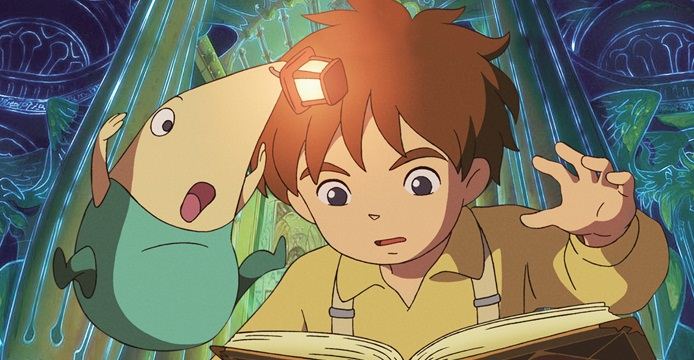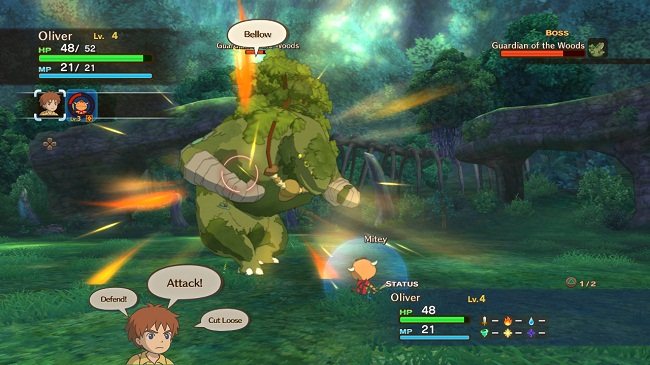George R. Gissing once famously wrote, “It is familiarity with life that makes time speed quickly. When every day is a step in the unknown, as for children, the days are long with gathering of experience…” With the wonder of childhood at the heart of any Studio Ghibli project, Ni No Kuni: Wrath of the White Witch is undoubtedly a special addition to their already rich tapestry of work. But why is this? Well, for the first time in their history (and with the help of the prestigious Level 5) Studio Ghibli are attempting to break the fourth wall beyond cinema and engage audiences, both new and old, through the immersive medium of gaming.
Whilst Ni No Kuni (strictly translated as “another world”) has been available for English DS owners and Japanese gamers for some time now, the PlayStation 3 is exclusively fortunate to receive this sort-of-port in all its vibrant, big-screen glory. The crisp blend of Ghibli animation and Level-5 production value make this a wholly stunning JRPG, however that’s not to say the game can be easily misinterpreted by newcomers to the genre, or to Ghibli fans themselves. While aesthetically the games’ surface glistens with charm and childlike simplicity, there is a deep underbelly that broods with emotion and adventure. Sadly this can only be appreciated fully if the gamer throws themselves head-first into the mechanics of the title and engage with the protagonist’s basic, yet widely accessible, tale…
The protagonist in question is a boy named Oliver, a good-natured young man who finds himself grief-stricken and bound by love to a mother who suddenly passes away. His tears ignite a lifeless doll (a humpty dumpty lookalike with a trendy lantern nose-ring) into animation, bursting with goofy humour and Welsh charm (the aptly named ‘Dippy’ is enjoyed a great deal more when playing with the English dub – now there’s a tip!). With the same depth of morality, heart and family bond we’ve seen in other works of Ghibli (most notably 2001’s Spirited Away) Oliver embarks on a quest with Dippy, now discovered to be King of the Fairies, to a parallel universe (the “Ni No Kuni” if you will) – using wizardry to revive his mother from death and to simultaneously end the corruptive powers of evil tyrant Shadar. It’s a coming of age story told the way Ghibli no best, by throwing a relatable protagonist into a minefield of wonder and fantastical danger – driven solely to the end by one overarching aim. Yet while the crux of the concept sounds appealing, the reality is arguably a different story.
As this is a videogame and not a film, a lot of Ghibli’s trademark qualities have to be sacrificed in order to satisfy a gaming audience. This is not the same case for Level-5, however, whose remarkable talents do nothing but flourish in a game like this (as we’ve seen previously with Dragon Quest 9). As you traverse beautiful lands and encounter strange enemies within the confines of the JRPG format, a lot of Ghibli’s surreal, unreadable, almost passive-aggressive beauty is replaced by generic game structuring. Whereby Toshioko Suzuki would traditionally opt to subvert any audience preconceptions with childlike, creative dramatics – he must be content here with the fact that this is contemporary videogaming entertainment and therefore will rely on a structure that we’ve seen before. It’s not particularly rigid, though, as you are free to roam the explorable open universe and capture and raise familiars in Final Fantasy meets Pokemon-esque battles.
Surprisingly, hand-drawn animation doesn’t feature as frequently as fans of the movies would expect – however Level-5’s wonderful adoption of Ghibli’s techniques mean the in-game engine is just as satisfying to watch when it comes to those crucial cut-scenes. For a Western audience, Ni No Kuni translates very well; the humour is sublime and the simplification of JRPG elements are welcome here. Battles are fought in teams, with you controlling one character at a time with the opportunity to swap at any given moment. These happen in real-time (i.e you’ll be dodging attacks and collecting health and mana replenishment items) however you do select your attacks from a pre-determined list which can often be quite a clumsy interface to use. Teammate AI isn’t anything spectacular and usually their support is basic (i.e – focusing on keeping you alive, targeting the enemy etc.) – however it’s your Pokem… I mean familiars that will give you the most satisfaction during fights. These strange little creatures have varying attributes and quite often can inflict great deals of damage to your opponents during battles. They evolve, or should I say ‘metamorphasise’, throughout your time with them – although be warned that they are capped at 3 evolutions so there’s only so far you can take them.
Studio Ghibli and Level-5 have given me exactly what I wanted from their joint-effort JRPG. There’s some beautiful animation, a hauntingly beautiful soundtrack orchestrated by Ghibli’s mistro Joe Hisaishi and a stellar cast of memorable characters – but these come at the cost of having a game that’s creatively limited due to the sheer restrictions of just being a videogame. Oliver’s is a story I’d quite like to see again, away from the combat and the grinding and the travelling – who knows, one day that may even happen? For now, though, I’m content with saying that Ni No Kuni: Wrath of the White Witch is one of the strongest JRPGs ever to grace a console – it’s perfect for entry level gamers too, so there’s no time to lose in picking this up and immersing yourself with its witty, wondrous ways. Just promise me you’ll never go to Cardiff.



0 Comments